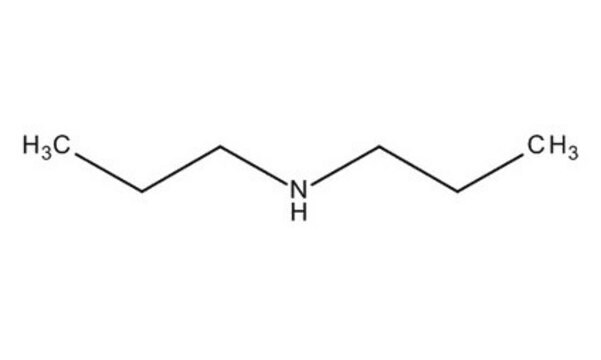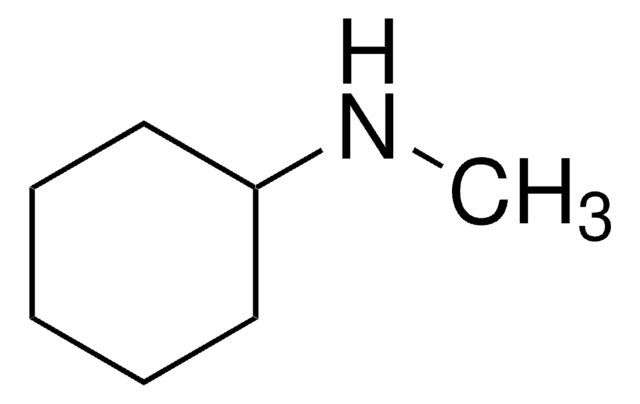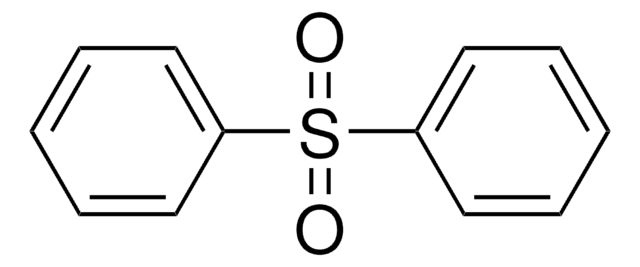D214752
Dipropylamine
99%
Synonym(s):
Di-n-propylamine, Dipropanamine, Dipropylamine (8CI), N,N-Di(n-propyl)amine, N,N-Dipropylamine, N-Propyl-1-propanamine, n-Dipropylamine
About This Item
Recommended Products
Assay
99%
form
liquid
refractive index
n20/D 1.4049 (lit.)
bp
105-110 °C (lit.)
density
0.738 g/mL at 25 °C (lit.)
SMILES string
CCCNCCC
InChI
1S/C6H15N/c1-3-5-7-6-4-2/h7H,3-6H2,1-2H3
InChI key
WEHWNAOGRSTTBQ-UHFFFAOYSA-N
Looking for similar products? Visit Product Comparison Guide
General description
Application
- Separation of hydrocarbons: Nitrogen-containing switchable solvents, including dipropylamine, are used for the separation of hydrocarbons and their derivatives, showcasing the compound′s versatility in solvent applications (Liu et al., 2020).
- Microextraction techniques: Dipropylamine-based dispersive micro-solid phase extraction combined with switchable hydrophilicity solvent is employed for enriching non-steroidal anti-inflammatory drugs from environmental water samples, demonstrating its utility in complex sample preparation (Di et al., 2020).
- Homogeneous liquid-liquid microextraction: A new pH assisted homogeneous liquid-liquid microextraction method utilizing dipropylamine as a solvent with switchable hydrophilicity was developed for the GC-MS determination of methamphetamine, highlighting its effectiveness in analytical chemistry applications (Shahvandi et al., 2018).
- Removal of contaminants: Research demonstrated the use of zeolite and powdered activated carbon in conjunction with dipropylamine for the simultaneous removal of ammonia and N-nitrosamine precursors from high ammonia water, underscoring its environmental application (Xue et al., 2018).
- Nanosized synthesis: Dipropylamine was used in a co-templating synthesis approach for the production of high-yield nanosized (Si)AlPO-41 using ethanol polarity equalization, illustrating its role in materials science (Majano et al., 2015).
Signal Word
Danger
Hazard Statements
Precautionary Statements
Hazard Classifications
Acute Tox. 3 Dermal - Acute Tox. 3 Inhalation - Acute Tox. 4 Oral - Eye Dam. 1 - Flam. Liq. 2 - Skin Corr. 1A - STOT SE 3
Target Organs
Respiratory system
Storage Class Code
3 - Flammable liquids
WGK
WGK 1
Flash Point(F)
44.6 °F - closed cup
Flash Point(C)
7 °C - closed cup
Personal Protective Equipment
Regulatory Listings
Regulatory Listings are mainly provided for chemical products. Only limited information can be provided here for non-chemical products. No entry means none of the components are listed. It is the user’s obligation to ensure the safe and legal use of the product.
FSL
Group 4: Flammable liquids
Type 1 petroleums
Hazardous rank II
Water insoluble liquid
ISHL Indicated Name
Substances Subject to be Indicated Names
ISHL Notified Names
Substances Subject to be Notified Names
JAN Code
D214752-25ML:
D214752-500ML:
D214752-VAR:
D214752-1L:
D214752-BULK:
Choose from one of the most recent versions:
Already Own This Product?
Find documentation for the products that you have recently purchased in the Document Library.
Customers Also Viewed
Our team of scientists has experience in all areas of research including Life Science, Material Science, Chemical Synthesis, Chromatography, Analytical and many others.
Contact Technical Service












